产品描述
*The optimal dilutions should be determined by the end user.
*Tips:
WB: 适用于变性蛋白样本的免疫印迹检测. IHC: 适用于组织样本的石蜡(IHC-p)或冰冻(IHC-f)切片样本的免疫组化/荧光检测. IF/ICC: 适用于细胞样本的荧光检测. ELISA(peptide): 适用于抗原肽的ELISA检测.
引用格式: Affinity Biosciences Cat# AF5234, RRID:AB_2837720.
展开/折叠
CTHBP; Cytosolic thyroid hormone binding protein; Cytosolic thyroid hormone-binding protein; KPYM_HUMAN; MGC3932; OIP 3; OIP-3; OIP3; OPA interacting protein 3; Opa-interacting protein 3; p58; PK muscle type; PK, muscle type; PK2; PK3; PKM; PKM2; pykm; Pyruvate kinase 2/3; Pyruvate kinase 3; Pyruvate kinase isozymes M1/M2; Pyruvate kinase muscle; Pyruvate kinase muscle isozyme; pyruvate kinase PKM; Pyruvate kinase, muscle 2; TCB; THBP1; Thyroid hormone binding protein 1; Thyroid hormone binding protein cytosolic; Thyroid hormone-binding protein 1; Tumor M2 PK; Tumor M2-PK;
抗原和靶标
Specifically expressed in proliferating cells, such as embryonic stem cells, embryonic carcinoma cells, as well as cancer cells.
- P14618 KPYM_HUMAN:
- Protein BLAST With
- NCBI/
- ExPASy/
- Uniprot
MSKPHSEAGTAFIQTQQLHAAMADTFLEHMCRLDIDSPPITARNTGIICTIGPASRSVETLKEMIKSGMNVARLNFSHGTHEYHAETIKNVRTATESFASDPILYRPVAVALDTKGPEIRTGLIKGSGTAEVELKKGATLKITLDNAYMEKCDENILWLDYKNICKVVEVGSKIYVDDGLISLQVKQKGADFLVTEVENGGSLGSKKGVNLPGAAVDLPAVSEKDIQDLKFGVEQDVDMVFASFIRKASDVHEVRKVLGEKGKNIKIISKIENHEGVRRFDEILEASDGIMVARGDLGIEIPAEKVFLAQKMMIGRCNRAGKPVICATQMLESMIKKPRPTRAEGSDVANAVLDGADCIMLSGETAKGDYPLEAVRMQHLIAREAEAAIYHLQLFEELRRLAPITSDPTEATAVGAVEASFKCCSGAIIVLTKSGRSAHQVARYRPRAPIIAVTRNPQTARQAHLYRGIFPVLCKDPVQEAWAEDVDLRVNFAMNVGKARGFFKKGDVVIVLTGWRPGSGFTNTMRVVPVP
种属预测
score>80的预测可信度较高,可尝试用于WB检测。*预测模型主要基于免疫原序列比对,结果仅作参考,不作为质保凭据。
High(score>80) Medium(80>score>50) Low(score<50) No confidence
研究背景
Glycolytic enzyme that catalyzes the transfer of a phosphoryl group from phosphoenolpyruvate (PEP) to ADP, generating ATP. Stimulates POU5F1-mediated transcriptional activation. Plays a general role in caspase independent cell death of tumor cells. The ratio between the highly active tetrameric form and nearly inactive dimeric form determines whether glucose carbons are channeled to biosynthetic processes or used for glycolytic ATP production. The transition between the 2 forms contributes to the control of glycolysis and is important for tumor cell proliferation and survival. Promotes in a STAT1-dependent manner, the expression of the immune checkpoint protein CD274 in ARNTL/BMAL1-deficient macrophages (By similarity).
ISGylated.
Under hypoxia, hydroxylated by EGLN3.
Acetylation at Lys-305 is stimulated by high glucose concentration, it decreases enzyme activity and promotes its lysosomal-dependent degradation via chaperone-mediated autophagy.
FGFR1-dependent tyrosine phosphorylation is reduced by interaction with TRIM35.
Cytoplasm. Nucleus.
Note: Translocates to the nucleus in response to different apoptotic stimuli. Nuclear translocation is sufficient to induce cell death that is caspase independent, isoform-specific and independent of its enzymatic activity.
Specifically expressed in proliferating cells, such as embryonic stem cells, embryonic carcinoma cells, as well as cancer cells.
Monomer and homotetramer. Exists as a monomer in the absence of D-fructose 1,6-bisphosphate (FBP), and reversibly associates to form a homotetramer in the presence of FBP. The monomeric form binds T3. Tetramer formation induces pyruvate kinase activity. The tetrameric form has high affinity for the substrate and is associated within the glycolytic enzyme complex. Exists in a nearly inactive dimeric form in tumor cells and the dimeric form has less affinity for the substrate. Binding to certain oncoproteins such as HPV-16 E7 oncoprotein can trigger dimerization. FBP stimulates the formation of tetramers from dimers. Interacts with HERC1, POU5F1 and PML. Interacts (isoform M2) with EGLN3; the interaction hydroxylates PKM under hypoxia and enhances binding to HIF1A. Interacts (isoform M2) with HIF1A; the interaction is enhanced by binding of EGLN3, promoting enhanced transcription activity under hypoxia. Interacts (isoform M2, but not isoform M1) with TRIM35; this interaction prevents FGFR1-dependent tyrosine phosphorylation. Interacts with JMJD8.
Belongs to the pyruvate kinase family.
研究领域
· Human Diseases > Endocrine and metabolic diseases > Type II diabetes mellitus.
· Human Diseases > Infectious diseases: Viral > Human papillomavirus infection.
· Human Diseases > Cancers: Overview > Viral carcinogenesis.
· Human Diseases > Cancers: Overview > Central carbon metabolism in cancer. (View pathway)
· Metabolism > Carbohydrate metabolism > Glycolysis / Gluconeogenesis.
· Metabolism > Nucleotide metabolism > Purine metabolism.
· Metabolism > Carbohydrate metabolism > Pyruvate metabolism.
· Metabolism > Global and overview maps > Metabolic pathways.
· Metabolism > Global and overview maps > Carbon metabolism.
· Metabolism > Global and overview maps > Biosynthesis of amino acids.
· Organismal Systems > Endocrine system > Glucagon signaling pathway.
文献引用
Application: WB Species: human Sample: MIA PaCa-2 cells
Application: WB Species: Human Sample: pancreatic cancer tissue
Application: WB Species: Human Sample: MCF-7 cells
Application: WB Species: Mouse Sample: BMSCs
限制条款
产品的规格、报价、验证数据请以官网为准,官网链接:www.affbiotech.com | www.affbiotech.cn(简体中文)| www.affbiotech.jp(日本語)产品的数据信息为Affinity所有,未经授权不得收集Affinity官网数据或资料用于商业用途,对抄袭产品数据的行为我们将保留诉诸法律的权利。
产品相关数据会因产品批次、产品检测情况随时调整,如您已订购该产品,请以订购时随货说明书为准,否则请以官网内容为准,官网内容有改动时恕不另行通知。
Affinity保证所销售产品均经过严格质量检测。如您购买的商品在规定时间内出现问题需要售后时,请您在Affinity官方渠道提交售后申请。产品仅供科学研究使用。不用于诊断和治疗。
产品未经授权不得转售。
Affinity Biosciences将不会对在使用我们的产品时可能发生的专利侵权或其他侵权行为负责。Affinity Biosciences, Affinity Biosciences标志和所有其他商标所有权归Affinity Biosciences LTD.






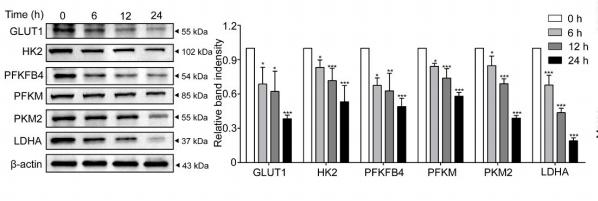
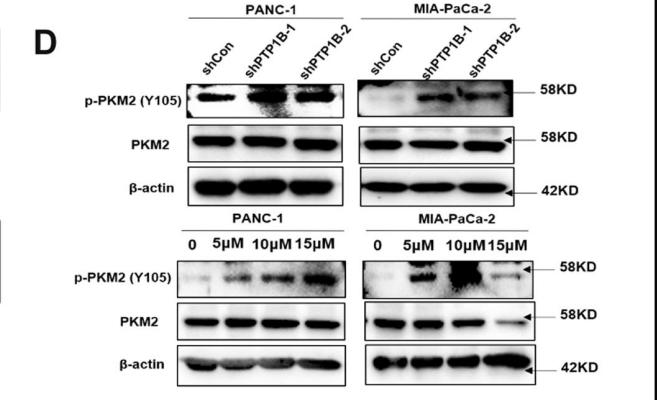
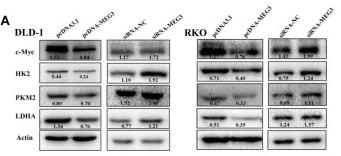
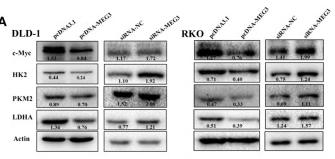
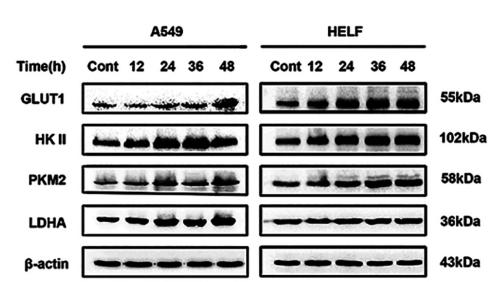


![Figure 5 BHD inhibited protein and mRNA expression of pyruvate kinase M2 (PKM2) and hypoxia-inducible factor-1 alpha (HIF-1α) as well as its target genes (GLUT1, PDK1, lactate dehydrogenase A [LDHA]) in aortas after high fat diet treatment. (a) Protein Levels of PKM2 were measured by Western blot analysis, and quantitative analysis was performed on the corresponding bands (n = 8–9). (b) Protein Levels of HIF-1α was measured by WB, and quantitative analysis was performed on the corresponding bands (n = 9). (c) The mRNA levels of GLUTA, (d) PDK1, and (e) LDHA in aortas (n = 6) were measured by qRT-PCR. Means ± standard error of mean. *P < 0.05, **P < 0.01, ***P < 0.001 versus Con; #P < 0.05, ##P < 0.01 versus Mod. PKM2 Antibody - Figure 5 BHD inhibited protein and mRNA expression of pyruvate kinase M2 (PKM2) and hypoxia-inducible factor-1 alpha (HIF-1α) as well as its target genes (GLUT1, PDK1, lactate dehydrogenase A [LDHA]) in aortas after high fat diet treatment.](http://img.affbiotech.cn/uploads/202409/5ce509e907ddfd09b9be49206226cfbb.png)

